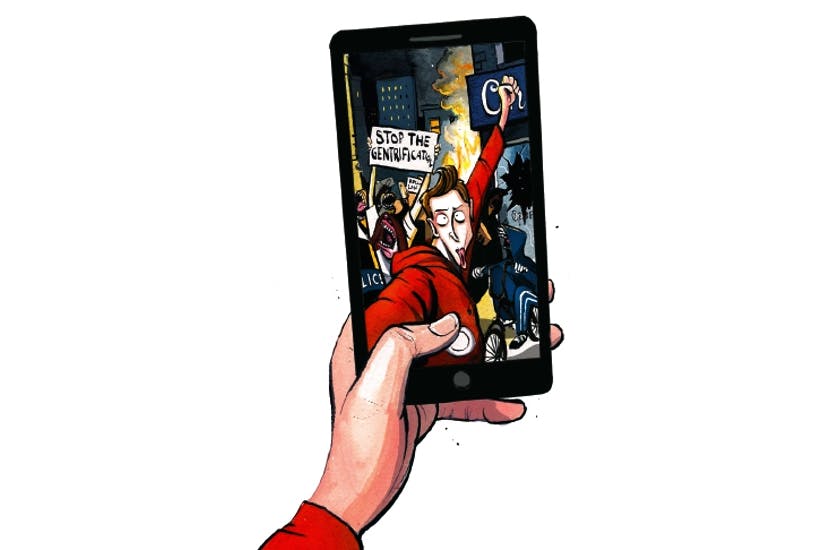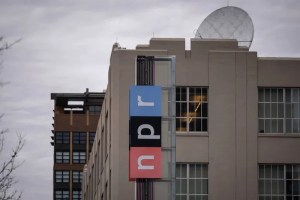If you have been following the Minneapolis riots on Twitter or Facebook, you may have come across an edgy new media channel called Unicorn Riot. The company is five years old and describes itself ‘viewer-supported’, ‘independent’ and ‘alternative’. In fact, it thrives by circulating images and videos of social unrest with indisputable glee — on riot porn, in other words. Unicorn Riot’s Twitter channel has about 150,000 followers. The account specializes in fanning the flames of racial aggravation. It also helpfully informs viewers where the National Guard blockades are in case anyone might want to avoid or attack them.
In the last few days Unicorn Riot has published countless images of street-level terrorism, along with vox pop interviews of the rioters, including one delightful young man in a bandana who says:
‘We’re gonna f*** y’all up. Matter of fact, we gotta two-for-one rule, n**** — one of ours, two of yours. Innocent mother****ers dying, coz y’all bitch ass n***z don’t want none. There’s more of us than you, b****. What’s up! Exactly! We coming for all y’all n***ers! This is only the beginning mother***er. What’s up!’
Martin Luther King couldn’t have put it better.
Twitter doesn’t seem too concerned about that sort of talk whistling around its network while a city burns. The company will, however, censor President Trump when he tweets the following in response to the riots:
….These THUGS are dishonoring the memory of George Floyd, and I won’t let that happen. Just spoke to Governor Tim Walz and told him that the Military is with him all the way. Any difficulty and we will assume control but, when the looting starts, the shooting starts. Thank you!
— Donald J. Trump (@realDonaldTrump) May 29, 2020
Twitter shielded that statement from public view because it ‘violated Twitter rules about glorifying violence’ — though, pompously citing the public interest, the company has allowed the tweet to remain available for those willing to click past the warning. Given the last two days of bickering between Trump and Twitter, the company’s decision to censor (that is the word) him this morning looks very much like an act of provocation, a trolling of the Troller-in-Chief.
But if you want an insight into how progressive thinking warps common sense, I can think of no better example. People on the streets calling for murder, arson and destruction — all in the name of racial justice, of course — are widely broadcast. A President calling for the restoration of law and order is muted. That’s the radical left’s idea of ‘social justice’. It has a bias towards anarchy.
Let’s put aside for a moment whether we think the President of the United States should be tweeting so glibly about a serious problem. The silly line about shooting and looting was a classic Trump provocation, and probably best ignored. But it is absurd for Twitter to try to grab the higher moral ground over the Commander-in-Chief while, through its platform, hooligans and criminals incite violence on the streets. That isn’t just a double-standard. It is a perversion of justice and it is divisive.
***
Get three months of The Spectator for just $9.99 — plus a Spectator Parker pen
***
Thanks to Trump’s recent moves against Twitter, there has been a lot of talk about publishers vs platforms. Conservatives are increasingly agreed that, if social media companies are to start editorializing content, they should no longer be free to absolve themselves of blame when their platforms are used to promote libel, criminal abuse or violence. Even more questions should be asked of social media when it comes to riots in the 21st century.
Social media and rioting are these days symbiotic: that’s why riot police jam phone signals to quell disturbances. It’s not just crass and pretentious channels such as Unicorn Riot. There are no end of popular social media accounts suggesting that the police have got what is coming to them: that now is only the start of a devastating revolt. Like all urban social phenomena, riots quickly turn into a form of middle-class entertainment. For many social media users, riot footage really is a kind of pornography — a crude performance art that titillates thrill-seekers from a safe and privileged distance. It’s true-crime, but deliciously live. It’s not so much fun for the people having their livelihoods and homes destroyed — but hey, who cares when such behavior is so memetic? The more images of smashed up shops and buildings in flames go viral, the more appetite there is to create them. We’re almost all guilty of gawping at scenes of street violence and rioters and it’s by no means all Twitter’s fault: rioters can and do use plenty of other networks to communicate. But if Twitter is going to start deciding what the President can and can’t say on its website, they should be held more accountable for their role in the wider glorification of violence we are seeing this week.


















